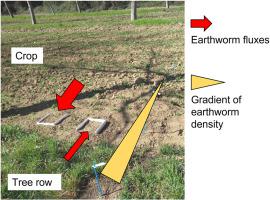当前位置:
X-MOL 学术
›
Eur. J. Soil Biol.
›
论文详情
Our official English website, www.x-mol.net, welcomes your feedback! (Note: you will need to create a separate account there.)
Tracking earthworm fluxes at the interface between tree rows and crop habitats in a Mediterranean alley cropping field
European Journal of Soil Biology ( IF 4.2 ) Pub Date : 2023-11-28 , DOI: 10.1016/j.ejsobi.2023.103572 Camille D'Hervilly , Isabelle Bertrand , Laurent Berlioz , Mickaël Hedde , Yvan Capowiez , Lydie Dufour , Claire Marsden
European Journal of Soil Biology ( IF 4.2 ) Pub Date : 2023-11-28 , DOI: 10.1016/j.ejsobi.2023.103572 Camille D'Hervilly , Isabelle Bertrand , Laurent Berlioz , Mickaël Hedde , Yvan Capowiez , Lydie Dufour , Claire Marsden

|
Alley cropping is the combination of tree rows and crop alleys. The tree row is covered by an understory vegetation strip (UVS), providing a beneficial habitat for many soil fauna, which could disperse through spillover to the crop alleys. However, such movements have never been directly studied. Our experiment investigated earthworm fluxes in the tree row vicinity using a trap technique, in a Mediterranean agroforestry alley cropping field cultivated with peas and planted with walnut trees. We assessed earthworm density at different distances from the UVS (0 m, 0.3 m, 1 m and 6 m) by hand sorting soil monoliths (25*25*30 cm) in spring 2019, at the start and the end of a two-month experiment. During this period, we detected earthworm fluxes by placing directional traps at 30 cm from the UVS border. Traps consisted of three glued plastic walls placed vertically in the soil. They delimited a soil block of 25*25 cm by 20 cm depth and were open on one side. More epigeic earthworms were found in the UVS and up to 30 cm from the UVS border than in the middle of the crop alley. By contrast, the earthworm presented a homogeneous distribution in the plot. Trapped earthworms were mostly of the species, and 1.6 times more earthworms were found in traps open towards the crop alley than in traps open towards the UVS. These results suggest that in spring, earthworms are moving more from the crop alley towards the UVS than in the other direction, probably using the tree row and its vicinity as a refuge against adverse summer conditions in the crop alley.
中文翻译:

跟踪地中海小巷种植田中树行和作物栖息地之间界面的蚯蚓通量
胡同种植是树木行和作物胡同的组合。树行被林下植被带 (UVS) 覆盖,为许多土壤动物提供了有益的栖息地,这些动物可以通过溢出到作物巷中扩散。然而,此类运动从未被直接研究过。我们的实验使用诱捕技术在种植豌豆和种植核桃树的地中海农林复合种植田中研究了树行附近的蚯蚓通量。我们在 2019 年春季,在两次试验开始和结束时,通过手工分类土壤块(25*25*30 cm),评估了距 UVS 不同距离(0 m、0.3 m、1 m 和 6 m)的蚯蚓密度。月实验。在此期间,我们通过在距 UVS 边界 30 厘米处放置定向陷阱来检测蚯蚓通量。陷阱由三个垂直放置在土壤中的胶合塑料墙组成。他们划定了一块 25*25 厘米、深 20 厘米、一侧开放的土块。在 UVS 和距离 UVS 边界 30 厘米处发现的表层蚯蚓比农作物巷中部的多。相比之下,蚯蚓在图中呈现均匀分布。被捕获的蚯蚓主要是该物种,并且在朝向农作物巷的陷阱中发现的蚯蚓是在朝向 UVS 的陷阱中发现的蚯蚓的 1.6 倍。这些结果表明,在春季,蚯蚓从作物巷向UVS移动的次数多于其他方向,可能利用树行及其附近作为农作物巷夏季不利条件的避难所。
更新日期:2023-11-28
中文翻译:

跟踪地中海小巷种植田中树行和作物栖息地之间界面的蚯蚓通量
胡同种植是树木行和作物胡同的组合。树行被林下植被带 (UVS) 覆盖,为许多土壤动物提供了有益的栖息地,这些动物可以通过溢出到作物巷中扩散。然而,此类运动从未被直接研究过。我们的实验使用诱捕技术在种植豌豆和种植核桃树的地中海农林复合种植田中研究了树行附近的蚯蚓通量。我们在 2019 年春季,在两次试验开始和结束时,通过手工分类土壤块(25*25*30 cm),评估了距 UVS 不同距离(0 m、0.3 m、1 m 和 6 m)的蚯蚓密度。月实验。在此期间,我们通过在距 UVS 边界 30 厘米处放置定向陷阱来检测蚯蚓通量。陷阱由三个垂直放置在土壤中的胶合塑料墙组成。他们划定了一块 25*25 厘米、深 20 厘米、一侧开放的土块。在 UVS 和距离 UVS 边界 30 厘米处发现的表层蚯蚓比农作物巷中部的多。相比之下,蚯蚓在图中呈现均匀分布。被捕获的蚯蚓主要是该物种,并且在朝向农作物巷的陷阱中发现的蚯蚓是在朝向 UVS 的陷阱中发现的蚯蚓的 1.6 倍。这些结果表明,在春季,蚯蚓从作物巷向UVS移动的次数多于其他方向,可能利用树行及其附近作为农作物巷夏季不利条件的避难所。



























 京公网安备 11010802027423号
京公网安备 11010802027423号